
The Corydon Historic District is a national historic district located in Corydon, Indiana, United States. The town of Corydon is also known as Indiana's First State Capital and as Historic Corydon. The district was added to the National Register of Historic Places in 1973, but the listing was amended in 1988 to expand the district's geographical boundaries and include additional sites. The district includes numerous historical structures, most notably the Old Capitol, the Old Treasury Building, Governor Hendricks' Headquarters, the Constitution Elm Memorial, the Posey House, the Kintner-McGrain House, and The Kintner House Inn, as well as other residential and commercial sites.

The Lower Woodward Avenue Historic District, also known as Merchant's Row, is a mixed-use retail, commercial, and residential district in downtown Detroit, Michigan, located between Campus Martius Park and Grand Circus Park Historic District at 1201 through 1449 Woodward Avenue and 1400 through 1456 Woodward Avenue. The district was listed on the National Register of Historic Places in 1999.
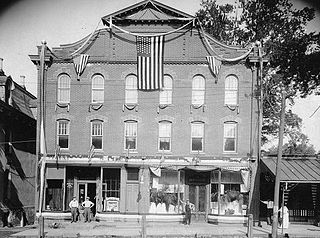
Newtown Hardware House is an independently owned hardware store located at 106 S. State Street, Newtown, Bucks County, Pennsylvania. The Newtown Hardware House is a contributing property of the Newtown Historic District which was listed on the National Register of Historic Places in 1979.
The Oyster Bay History Walk is a path through downtown Oyster Bay, New York that leads the walker to 30 historic sites. It is a 1-mile loop and is the first certified American Heart Association Start! Walking Path on Long Island.
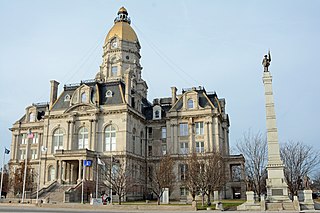
The Vigo County Courthouse is a courthouse in Terre Haute, Indiana. The seat of government for Vigo County, the courthouse was placed on the National Register of Historic Places in 1983.
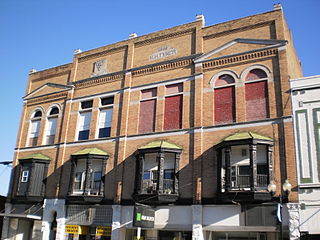
The Hartford City Courthouse Square Historic District is located in Hartford City, Indiana. Hartford City has a population of about 7,000 and is the county seat of Blackford County and the site of the county courthouse. The National Park Service of the United States Department of the Interior added the Hartford City Courthouse Square Historic District to the National Register of Historic Places on June 21, 2006 — meaning the buildings and objects that contribute to the continuity of the district are worthy of preservation because of their historical and architectural significance. The District has over 60 resources, including over 40 contributing buildings, over 10 non-contributing buildings, 1 contributing object, 8 non-contributing objects, and two other buildings that are listed separately in the National Register.
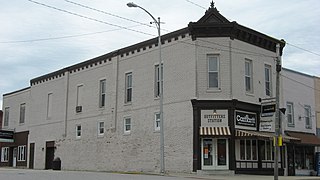
The Palace Lodge is a historic commercial building in the small town of Winslow, Indiana, United States. Since its construction in the late nineteenth century, the building has been the location of several businesses, the meeting place for two different secret societies, and the center of the town's commercial district. It has been declared a historic site because of its historically significant architecture.

McClellan's General Store is an historic structure located in New London, Iowa, United States. James and Adeline McClellan moved to Henry County in 1856. He bought the lot for $365 in 1867 and had the building built for a mercantile business that he founded the same year. It was the first building constructed in the simplified Italianate style in town He added dry goods to his store in 1875 and the business was renamed McClellan and Stottard Dry Goods Store at about the same time. The McClellan family used the second floor as their residence for several years The building was listed on the National Register of Historic Places in 2003.

The Fifth and Main Historic District is a collection of adjoining structures and national historic district located on the northeast corner of the intersection of Main and Fifth streets in Joplin, Jasper County, Missouri, United States. This historic district consists of three early 20th century structures: the Christman Building, the Christman Building Annex and the Paramount Building. The Fifth and Main Historic District was added to the National Register of Historic Places in 2006. In 2008, it was encompassed by the Joplin Downtown Historic District.

Upper Main Street Historic District is a national historic district located at Lafayette, Tippecanoe County, Indiana. Sixth Street was the City of Lafayette's eastern boundary when it was originally platted. By 1840, the boundary was extended to include Lake Erie and Wabash Railroad at Eleventh Street. This area became the cities commercial center. Businesses around Eleventh Street developed to meet the traveling publics needs. The Enterprise Hotel, at 1015 Main Street, as well as the Alt Heidelberg, American Lafayette and the Derby Hotel were early established by 1899.

Located in Chesterton, Indiana, the Chesterton Residential Historic District is located a block south of the business district, along Second Street from Indiana Ave. to Lincoln Ave. and on Indiana Ave. from Second to Third Streets. The area began with the Martin Young House construction about 1870. The Historic Landmarks Foundation of Indiana describes as one of the best Italianate structures remaining in northwest Indiana. Most of the structures date from the early twentieth century. St. Patrick's Catholic Church, built in 1876, and burned ca. 2000.

Downtown Aurora Historic District is a national historic district located at Aurora, Dearborn County, Indiana. The district encompasses 272 contributing buildings, 1 contributing site, and 3 contributing structures in the central business district of Aurora. The district developed between about 1830 and 1944, and includes notable examples of Italianate, Federal, and Greek Revival style architecture. Located in the district are the separately listed Aurora City Hall, Aurora Methodist Episcopal Church, Aurora Public Library, First Evangelical United Church of Christ, First Presbyterian Church, George Street Bridge, Hillforest, Lewis Hurlbert, Sr. House, Leive, Parks and Stapp Opera House, and George Sutton Medical Office. Other notable buildings include the T. and J.W. Gaff Distillery (1843), First National Bank (1924), I.O.O.F. Hall (1887), B&O Railroad Station (1911-1917), John Neff Building, Chamber Stevens & Co. Dry Goods Store, U.S. Post Office (1935), Star Milling Co. (1891), and St. John's Evangelical Lutheran Church (1874).

Goshen Historic District is a national historic district located at Goshen, Elkhart County, Indiana. The district encompasses 751 contributing buildings and 1 contributing site in the central business district and surrounding residential sections of Goshen. The town was developed between about 1840 and 1930, and includes notable examples of Italianate and Queen Anne style architecture. Located with in the district are the separately listed Elkhart County Courthouse and Goshen Carnegie Public Library. Other notable buildings include the Kindy Block (1881), Central Block (1882), Spohn Building (1909), Harper Block (1888), Noble Building, Jefferson Theater (1907), General Baptist Church (1859), First Methodist Church (1874), and St. James Episcopal Church (1862).

Plainfield Historic District is a national historic district located at Plainfield, Hendricks County, Indiana. The district encompasses 174 contributing buildings in the central business district and surrounding residential area of Plainfield. The district developed between about 1840 and 1959 and includes notable examples of Greek Revival, Gothic Revival, Italianate, Queen Anne, and Bungalow / American Craftsman style architecture. Notable buildings include the Ezra Cox House, Oscar Hadley House (1891), Plainfield Carnegie Library (1912), Plainfield Methodist Episcopal Church (1891), Bly Bros. Dry Goods Store, Knights of Pythias Building, Prewitt Theater (1927), First National Bank of Plainfield (1903), Mansion House Hotel (1874), Fisher's Tavern, and Quaker Meeting House (1857-1858).

Lowell Commercial Historic District is a national historic district located at Lowell, Lake County, Indiana. The district encompasses 28 contributing buildings, 1 contributing site, and 1 contributing object in the central business district of Lowell. It developed between about 1870 and 1952, and includes notable example of Italianate, Queen Anne, Romanesque Revival, Bungalow / American Craftsman, and Art Deco style architecture. Notable buildings include the Roberts Building (1948), Colfax Lodge (1898), Bacon House, Lowell National Bank (1903), Lowell Town Hall (1922), and Lowell Carnegie Library (1920).
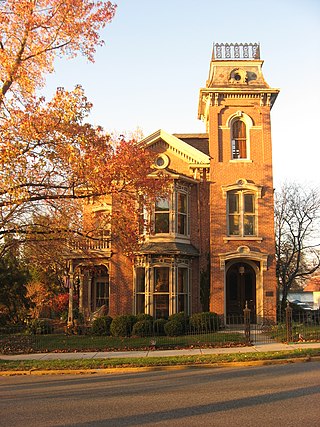
James H. Ward House is a historic home located at Lafayette, Tippecanoe County, Indiana. It was built about 1875, and is a two-story, Italianate / Second Empire style brick dwelling, with a 3+1⁄2-story mansard roofed tower. It features deep overhanging eaves with corner brackets, asymmetrical massing, and an ornate semi-hexagonal, two-story projecting bay. Also on the property is a contributing carriage house.
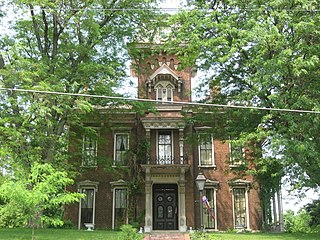
Judge Cyrus Ball House, also known as the Ball Mansion and Carriage House, is a historic home located at Lafayette, Tippecanoe County, Indiana. It was built in 1868–1869, and is a two-story, Second Empire style brick dwelling, with a three-story mansard roofed entrance tower. It sits on a limestone foundation, has intricate wood and stone detailing, and a slate roof. Also on the property is a contributing two-story, rectangular carriage house.
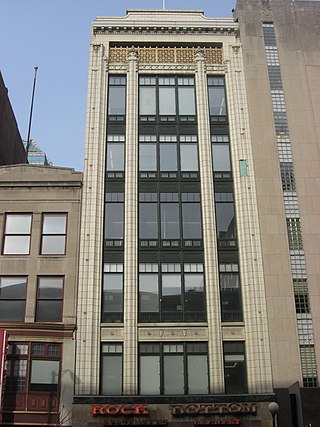
Selig's Dry Goods Company Building, also known as Morrisons/Em-roe Sporting Goods Company, is a historic commercial building located at Indianapolis, Indiana. It was built in 1924, and is a seven-story, rectangular, Beaux-Arts style building with a white terra cotta and aluminum front facade. It was remodeled in 1933. The building features tinted plate glass windows and a terra cotta Roman thermal window-like screen at the top floor. The building housed the Selig's Dry Goods Company, in operation until 1933.

The Bradley House is a restored single-family home, now used as a museum, located at 3200 Cook Road in Midland, Michigan, on the grounds of the Midland County Historical Society Heritage Park. The house was listed on the National Register of Historic Places in 1972.

Rankin's was a department store at 117 W. Fourth Street at Sycamore in downtown Santa Ana, California. The Rankin Building is listed on the National Register of Historic Places on its own and also as a contributing property of the Downtown Santa Ana Historic Districts.























